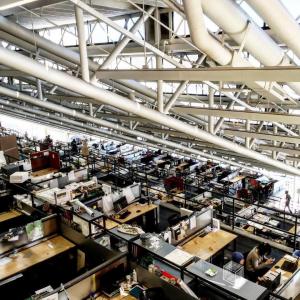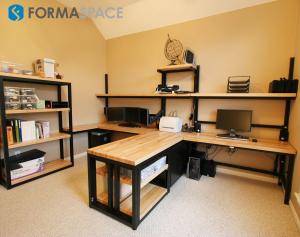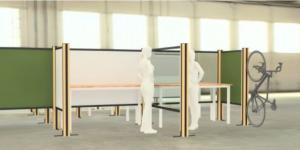12 Design and Planning Solutions When Renovating Education Facilities

When Harvard University’s Graduate School of Design wanted to renovate the student studio workstations in the landmark Gund Hall building, they turned to Formaspace to build custom reproduction furniture to match the original mid-century modern design.
As educational institutions won’t return to the “pre-pandemic” normal any time soon, find out how to plan for the school design in the Post-Covid era.
But will schools ever return to the status quo ante?
Probably not.
Just as in the case of the 1918 Spanish Flu outbreak, which helped bring about significant changes in school design – from increased fresh air ventilation to gleaming white sanitary ceramic fixtures and tiled floors in restrooms — the Covid-19 pandemic will have long-lasting effects on school design planning.
So what should architects and designers expect when drawing up programming plans for new school construction projects or renovations?
1. In-Person Education Is A Key Success Indicator
Most educational professionals agree on two findings from the sudden switch to remote learning during the height of the Coronavirus pandemic in 2020:
The first finding is that the majority of schools across the country did a remarkable job during these unprecedented circumstances to meet the immediate educational needs of their students through remote learning.
The second finding is that, despite these heroic efforts of teachers and parents, many students taught exclusively via remote learning fell behind in their studies and will need significant remedial tutoring to catch up to their grade level.
Why is there such a disparity between remote learning and in-person education outcomes?
Educators point to several factors at work during the pandemic:
- Students living in households where both parents work outside the home were at a significant disadvantage due to lack of at-home supervision – especially children of essential workers who continued to work during the pandemic.
- Disparities in home environments made remote learning more difficult for many students due to limited Internet access or inadequate study spaces to students lacking stable, permanent housing (e.g. homeless).
- Educators also found it was difficult to perform formative and summative assessments of student progress when interacting with students exclusively by remote video connections.
- Students educated exclusively in remote learning also lacked access to important course enrichment activities, including music, art, and theater programs; use of school laboratory facilities or maker spaces for hands-on project learning; as well as participation in physical education programs held in gymnasiums, swimming pools, athletic fields, etc.
- Educators also noted that students educated by remote learning (particularly younger students or special needs children) did not develop socialization skills at the same rate as compared to students receiving in-person education.
2. Create Multiple Education Pathways For Maximum Flexibility
For school architects and designers, one of the major takeaways from the coronavirus pandemic is the need to introduce flexibility into facility design.
This point was driven home during the past year as schools tentatively reopened to bring students back to campus.
In doing so, school facility managers needed to quickly reconfigure classrooms to reduce the overall student density (in accordance with the social distancing recommendations from the CDC) as well as installing transparent dividers and other sanitation measures, such as handwashing stations.
The scramble to reconfigure student classrooms was significantly easier at facilities that utilized flexible interior design features, such as reconfigurable movable wall dividers as well as mobile, modular furniture elements that could be quickly reconfigured in accordance with the changing requirements issued by the CDC.
On the other hand, facilities with fixed walls and fixed furniture designs, such as built-in cabinets or benches, were at a comparative disadvantage due to their inherently limited flexibility for making changes on the fly.
The bottom line?
School architects and interior designers will want to adopt highly flexible floor plan layouts as well as so-called “hackable” mobile furniture elements, such as portable, roll-able space dividers, whiteboards, computer screen stands, mobile storage carts, sound control panels, etc. that allow school facility managers to reconfigure spaces by easily moving furniture elements into places where they are needed – without the need for the disruptive downtime associated with even the most minimal of remodeling projects.
3. Hybrid Learning Is Here To Stay Because It’s Compatible With Project-Based Learning And Flipped Classrooms
In our first point above, we stated that when educators are given a binary choice between in-person education and remote learning, in-person education is preferred.
But does that mean that remote education is inherently bad?
Not exactly.
While the evidence indicates that students being taught exclusively by remote education are at a disadvantage compared to those who receive full-time in-person teaching, there are indications that combining in-person education with remote education – the so-called “hybrid learning” model — is a promising alternative.
But as it turns out, hybrid learning is not a new concept. Hybrid learning had become a mainstay for many students participating in “flipped classrooms” for a number of years now, e.g. starting prior to the onset of the pandemic.
In the flipped classroom approach, teachers no longer stand at the front of the classroom giving lectures at the whiteboard; instead, they serve as a learning facilitator or coach to help the students learn the material, either by studying it on their own or by participating in group projects (e.g. project-based learning).
In this flipped classrooms approach, students are typically assigned to learn classroom materials at home, reserving the time in the school classroom for participating in group learning projects or for asking for assistance from the teacher.
So, in effect, flipped classrooms have been relying on a form of hybrid learning all long, by assigning students homework in the form of reading textbooks, logging into computer-based training materials, or participating in remote video sessions with school tutors or teaching assistants.
The caveats we brought up earlier about unequal access for disadvantaged students remain a problem – but schools can help overcome these issues by offering after-school access to library facilities with computers and Internet access or by issuing students computer equipment and Wi-Fi access points for use in the home.
It’s a good bet that this form of hybrid learning (based on flipped classrooms and project-based learning) will become more widely adopted in the future thanks to its inherent flexibility.
For example, if the pandemic reverses and becomes more severe (or another pandemic arises in its place), it’s fairly easy to dial back the in-person education component of hybrid learning as needed.
4. Accommodate Tighter Connections To Industry And Jobs By Leveraging Schools As A Regional Economic Driver
Cities across the country are recognizing the connection between having an educated workforce and economic growth and prosperity.
And given that the jobs of tomorrow are increasingly technical, education facility architects and designers should be on the lookout for opportunities to enhance student education in science, technology, engineering, (the arts) and mathematics, collectively known as STEM (or STEAM if you include the arts component).
The best STEM/STEAM educational programs in the country feature well-equipped science laboratories for project-based learning, computer laboratories for teaching programming, and maker spaces with high-bay rollup doors to give students opportunities to learn how to make things by hand or use programmable tools, such as CNC machines or 3D printing technology.
Read more...
Julia Solodovnikova
Formaspace
+1 800-251-1505
email us here
Visit us on social media:
Facebook
Twitter
LinkedIn
Legal Disclaimer:
EIN Presswire provides this news content "as is" without warranty of any kind. We do not accept any responsibility or liability for the accuracy, content, images, videos, licenses, completeness, legality, or reliability of the information contained in this article. If you have any complaints or copyright issues related to this article, kindly contact the author above.


